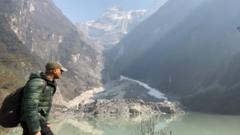In the heart of the Himalayan region, changing weather patterns and increasing pollution levels have resulted in recurring haze that shrouds the iconic mountain range. For many trekkers and tourists in Nepal, witnessing the majestic peaks of the Himalayas has become a challenging endeavor. Reports indicate that despite the area's historical reputation for breathtaking views, hikers and tourists alike are often greeted by thick haze rather than the panoramic vistas they sought.
For frequent visitors like Australian tourist John Carrol, the change has been disheartening. “It wasn't like this ten years ago, but now the haze seems to have taken over,” he lamented. This sentiment is echoed by local trekking guide Lucky Chhetri, whose business has plummeted by 40% as tourists find themselves unable to glimpse the mountains they traveled so far to see. In some cases, companies have even had to offer financial compensation to disappointed visitors who missed out on expected views.
The prolonged dry seasons, driven by climate change and exacerbated by elements like vehicular emissions and crop burning in nearby regions, have increased the intensity and duration of haze conditions—further diminishing visibility. Stunningly, data shows that the days with visibility issues at the Pokhara airport in Nepal have skyrocketed from just 23 days in 2020 to 168 in 2024, reflecting the troubling trend across the region.
Moreover, the effects of haze are not limited to Nepal alone. Areas across Northern India are experiencing similar challenges, with local hoteliers noting that hazy conditions have become denser and returned quicker than in years past, altering the tourism landscape drastically. While some tourists remain optimistic and return for a second chance in hopes of clearer skies, the outlook for businesses that rely on mountain views is beginning to look grim.
Experts suggest that the Himalayas may be among the most severely impacted mountain ranges globally, largely due to their location in densely populated areas facing high pollution levels. Addressing the root causes of this air quality crisis will be essential if locals and visitors alike hope to regain access to the stunning natural beauty that has inspired countless generations.
As trekking operators express deep concerns about their futures in light of the haze, they face the growing challenge of promoting an experience that no longer caters to the iconic views expected by visitors, leading many to consider alternative livelihoods. “We are left to do business with guilt when we are unable to show our clients the mountains that they pay us for,” Chhetri concludes, underscoring the loss of this treasured heritage to pollution and climate inaction.


















